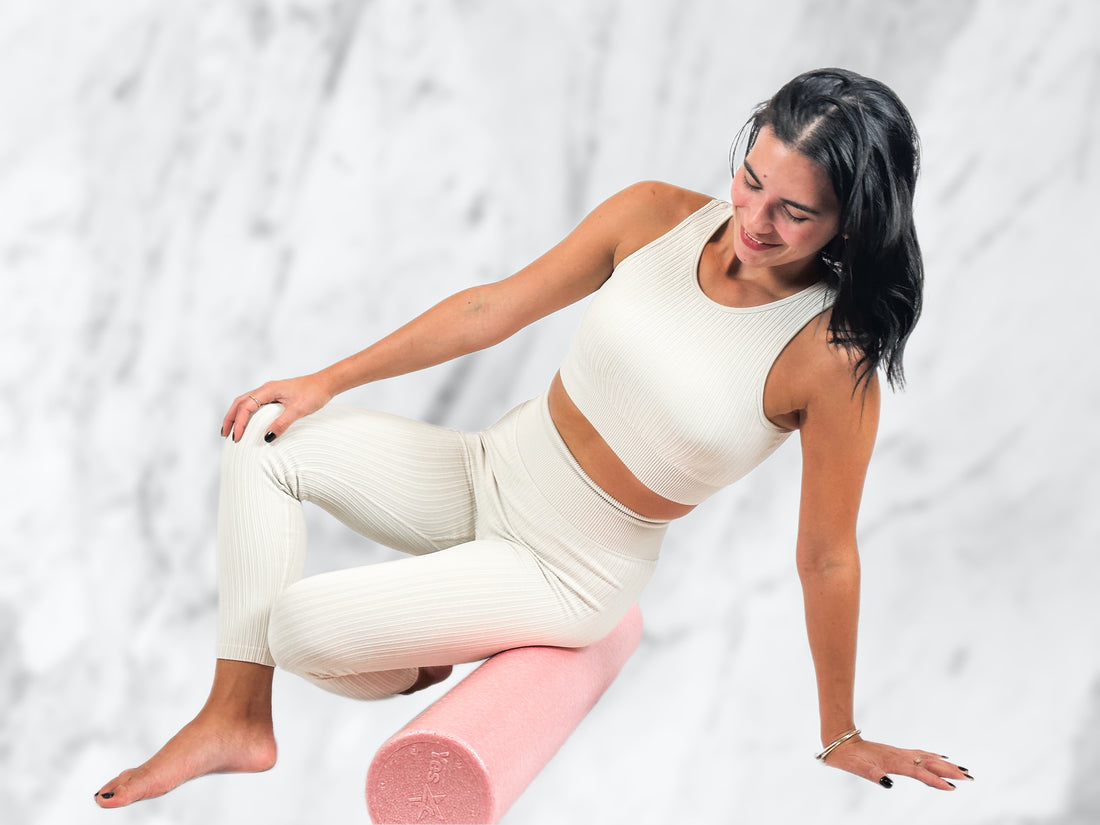(Español abajo)
''I have a knot in my back.''
Have you ever heard that statement? more interesting yet, have you ever relate to it? Do you know what is that «knot»?
Well, let me introduce you to the cause of those knots and one of the many ways you could release that tension. First, you need to understand what Myofascial is.
Myofascial is a very thin layer of skin that surrounds your muscles. It allows the movement of your muscles within its range of motion. To understand it a little better, think of a lemon cut in half, the white part covering the inside and dividing the lemon in several pieces will be similar to the function of the fascia in your body. Over time, due to the capacity of your muscles mobility, this fascia can get tense, creating then the sensation of «having a knot» in your back, shoulders o any other areas of your body.
Now that you understand what Myofascial is, let’s talk about foam rollers.
Foam rollers are a foam in a cylinder shape, very light and very functional. Foam rollers not also let you release tension, it also helps you to improve your flexibility. It also helps to stimulates blood flow to the muscles, which is crucial for delivering oxygen and nutrients to the tissues. Improved circulation not only aids in recovery but also supports overall muscle health. This enhanced blood flow can also contribute to a warming effect, making muscles more pliable and responsive to stretching. You can place it in the area of the body that has that tightness or soreness and start rolling. Most of the movement is done by you, so you choose what part of the body to roll. Example, are you having a leg workout? Upper body? Maybe you just slept in an uncomfortable position and you need to release that tension. Wherever you choose to roll over, you only need to do it for 90 seconds. After those 90 secs per area, you can start your warm up or simply start with your day.
Couple of examples of when to use a foam roller:
- After having an intense strength based fitness workout.
- Anytime you feel sore.
- When you are trying to increase your flexibility.
Four important things to keep in mind if you decide to start foam rolling:
- Foam rollers are economically accessible.
- Avoid creating co-dependance of this practice. You do not need it, but it is a helpful tool.
- Know your body and do not roll if you have an injure. Please always reach out to your doctor or physical therapist.
- An alternative to foam rolling before exercising is having a moderated warm-up and effective cool-down.
Hope this info helps and know you know how to release that knot!
—————————————
''Tengo un nudo en la espalda''
¿Alguna vez has escuchado esa frase? Aún más interesante, ¿alguna vez te has sentido identificado con ella? ¿Sabes qué es ese «nudo»?
Bueno, permíteme presentarte a la causa de esos nudos y una de las muchas maneras en que podrías liberar esa tensión. Primero, necesitas entender qué es el Miofascial.
El Miofascial es una capa muy delgada de piel que rodea tus músculos. Incrementa el movimiento de tus músculos dentro de su rango de movimiento. Para entenderlo un poco mejor, piensa en un limón cortado por la mitad, la parte blanca que cubre el interior y divide el limón en varios trozos será similar a la función de la fascia en tu cuerpo. Con el tiempo, debido a la capacidad de movilidad de tus músculos, esta fascia puede tensarse, creando así la sensación de «tener un nudo» en la espalda, hombros u otras áreas de tu cuerpo.
Ahora que comprendes qué es el miofascial, hablemos de los rodillos de espuma(foam rollers).
Los rodillos de espuma son un cilindro ligero y muy funcional. No solo te permiten liberar la tensión, sino que también te ayudan a mejorar tu flexibilidad. También estimulan el flujo sanguíneo hacia los músculos, lo cual es crucial para llevar oxígeno y nutrientes a los tejidos. El buen flujo sanguíneo no solo ayuda en la recuperación sino que también respalda la salud general de los músculos. Este flujo sanguíneo mejorado también puede contribuir a un efecto de calentamiento, haciendo que los músculos sean más maleables y receptivos al estiramiento. Puedes colocarlo en la zona del cuerpo que tenga esa rigidez o dolor y empezar a rodar. La mayor parte del movimiento la haces tú, así que eliges qué parte del cuerpo rodar. Por ejemplo, ¿vas a hacer ejercicio para las piernas? ¿Para la parte superior del cuerpo? Tal vez simplemente dormiste en una posición incómoda y necesitas liberar esa tensión. Donde elijas rodar, solo necesitas hacerlo durante 90 segundos. Después de esos 90 segundos por area, puedes comenzar tu calentamiento o simplemente empezar tu día.
Algunos ejemplos de cuándo usar un rodillo de espuma:
1. Después de realizar un entrenamiento de fuerza intenso.
2. Si te sientes dolor muscular causado por el ejercicio.
3. Cuando estás tratando de aumentar tu flexibilidad.
Cuatro cosas importantes a tener en cuenta si decides empezar a usar el rodillo de espuma:
1. Los rodillos de espuma son económicamente accesibles.
2. Evita depender demasiado de esta práctica. No es necesario, pero es una herramienta útil.
3. Conoce tu cuerpo y no lo uses si tienes una lesión. Siempre comunícate con tu médico o fisioterapeuta.
4. Una alternativa al rodillo de espuma antes de hacer ejercicio es realizar un calentamiento activo y un enfriamiento efectivo después de la practica.
¡Espero que esta información sea útil y ahora sepas cómo liberar ese nudo!
________________________________________________________
References:
https://www.nytimes.com/2022/07/13/well/foam-rolling-exercises.html
https://www.health.harvard.edu/blog/what-to-do-with-that-foam-roller-at-the-gym-2019041616427
https://www.sciencedirect.com/science/article/abs/pii/S136085921930395X

